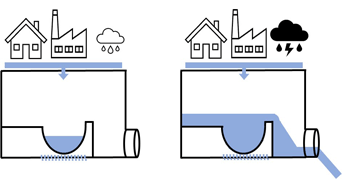Themed collection Water pollution

Electrochemical detection of heavy metal ions in water
Electrochemical sensors demonstrate outstanding performance at detecting heavy metal ions, with a high specific surface area and high sensitivity which can excellently complete the on-site detection of trace heavy metal ions in water.

Chem. Commun., 2021,57, 7215-7231
https://doi.org/10.1039/D1CC00983D
Prospects of 2D graphdiynes and their applications in desalination and wastewater remediation
Graphdiyne 2D-nanomaterial having uniform pores structure favor its applications in wastewater remediation. This article provides deep insights into GDY's structure, properties, synthesis methods, and its applications in wastewater treatment.

RSC Adv., 2023,13, 18568-18604
https://doi.org/10.1039/D3RA01370G
Bubble-propelled micro/nanomotors: a robust platform for the detection of environmental pollutants and biosensing
Recently, bubble-propelled micro/nanomotors have been considered as the cutting-edge micro/nano-sensing tools that use their unique features for fast detection of various hazardous environmental pollutants and biosensing.

Mater. Adv., 2023,4, 1460-1480
https://doi.org/10.1039/D2MA00798C
Water treatment using stimuli-responsive polymers
Stimuli-responsive polymers are a new category of smart materials used in water treatment via a stimuli-induced purification process and subsequent regeneration processes.

Polym. Chem., 2022,13, 5940-5964
https://doi.org/10.1039/D2PY00992G
Current trends in the detection and removal of heavy metal ions using functional materials
The shortage of freshwater resources caused by heavy metal pollution is an acute global issue, which has a great impact on environmental protection and human health.

Chem. Soc. Rev., 2023,52, 5827-5860
https://doi.org/10.1039/D2CS00683A
How natural materials remove heavy metals from water: mechanistic insights from molecular dynamics simulations
We investigate via atomistic simulations the capture of lead ions from water by hemicellulose – as representative of the polysaccharides that are common components of vegetables and fruit peels – and the reverse process.

Chem. Sci., 2021,12, 2979-2985
https://doi.org/10.1039/D0SC06204A
A luminescent cationic MOF and its polymer composite membrane elicit selective sensing of antibiotics and pesticides in water
Medicines and pesticides are being used excessively, misused, or abused in recent times, resulting in major environmental contamination and, more specifically, water pollution.

Mol. Syst. Des. Eng., 2023,8, 1483-1491
https://doi.org/10.1039/D3ME00008G
Construction and hydrophilic modification of dual-network structured nonwoven/UHMWPE composite membranes for water processing
Water pollution caused by the continuous development of industrialization has always been a common concern of mankind.

RSC Adv., 2023,13, 18480-18487
https://doi.org/10.1039/D3RA00920C
Combined sewer overflows: relating event duration monitoring data to wastewater systems' capacity in England
Water pollution caused by the frequent use of combined sewer overflows (CSOs) has been attracting increased media and political coverage in England as in other places in the world.

Environ. Sci.: Water Res. Technol., 2023,9, 707-722
https://doi.org/10.1039/D2EW00637E
3D printable polyethyleneimine based hydrogel adsorbents for heavy metal ions removal
A 3D printed hydrogel-based adsorbent provides an easy, eco-friendly, and cost-effective way to remove heavy metal ions from aqueous environments.

Environ. Sci.: Adv., 2022,1, 443-455
https://doi.org/10.1039/D2VA00064D
Active site regulated Z-scheme MIL-101(Fe)/Bi2WO6/Fe(III) with the synergy of hydrogen peroxide and visible-light-driven photo-Fenton degradation of organic contaminants
The band structure analysis shows that BWO and MIL-101(Fe) is typical type-II scheme, which provokes that the photogenerated carriers will transfer from a more positive position to a more negative position. The Z-scheme heterojunction is proposed.

Nanoscale, 2022,14, 7055-7074
https://doi.org/10.1039/D1NR07915H
Construction of SnNb2O6/MgIn2S4 heterojunction photocatalysts with enhanced visible-light-driven activity for tetracycline hydrochloride degradation and Cr(VI) reduction
A novel type II SnNb2O6/MgIn2S4 composite photocatalyst was prepared. The prepared composite photocatalyst exhibited significantly improved photocatalytic activity for Cr(VI) reduction and tetracycline hydrochloride degradation under visible light.

Catal. Sci. Technol., 2022,12, 2328-2339
https://doi.org/10.1039/D2CY00262K
Design of an efficient, tunable and scalable freestanding flexible membrane for filter application
Severe impacts of water contamination on the environment and human health have compelled us to study and design an efficient and reusable filter with tunable pore size.

RSC Adv., 2022,12, 1550-1562
https://doi.org/10.1039/D1RA07423G
An electroactive single-atom copper anchored MXene nanohybrid filter for ultrafast water decontamination
An electroactive and free-standing nanohybrid filter, consisting of single Cu atoms and MXene, enables ultrafast degradation of emerging contaminants.

J. Mater. Chem. A, 2021,9, 25964-25973
https://doi.org/10.1039/D1TA07396F
Piezoelectric activation of peroxymonosulfate by MoS2 nanoflowers for the enhanced degradation of aqueous organic pollutants
MoS2 NFs have exhibited abundant active sites in odd-number layers to piezoelectrically activate PMS for producing ˙OH and SO4˙− in order to degrade organic pollutants.

Environ. Sci.: Nano, 2021,8, 784-794
https://doi.org/10.1039/D0EN01237H
Microcystin in source water: pollution characteristics and human health risk assessment
Frequent cyanobacterial blooms in eutrophic waters produce a variety of toxins such as microcystins (MCs), which are seriously harmful to waterbodies and human health.

RSC Adv., 2021,11, 6415-6422
https://doi.org/10.1039/D0RA08983D
About this collection
The UK’s water is in poor health: toxic per- and polyfluoroalkyl substances (PFAS), used widely in manufacturing processes and consumer products for many years, are now prevalent in Britain’s rivers and water sources. The fragmentation of responsibilities and expertise in the current UK chemicals regulation system has resulted in a lack of regulatory controls on PFAS use and disposal, leaving both the public and wildlife exposed. We are calling on the UK Government to consider new statutory standards for PFAS levels in water, and to develop accredited analytical methods for PFAS monitoring and measurement - both essential for public health and safety.
This collection of research showcases some of the innovative approaches to water pollution being tackled by teams around the world.